Barberry
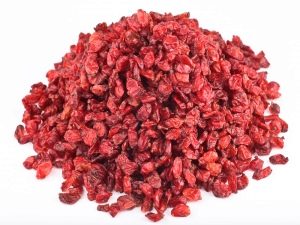
Barberry (Berberis vulgaris) is a member of the Barberry family. In German, the plant was named Agendorn, Dreidom, Sauerdorn, in English - barberry, berbery, in French - agrivoutier, berberis, vinettier.
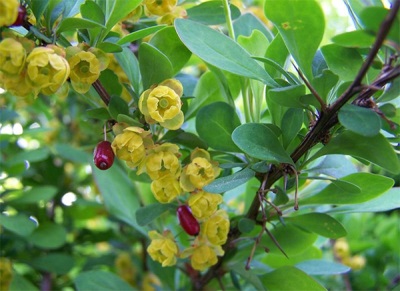
Appearance
More often, barberry grows in the form of shrubs, sometimes it is a small tree. The maximum height of the shrub can reach up to 4 m in height. However, usually the average height is no more than 2 m. The leaves of the barberry are oval, ovoid in shape and reach 3 cm in length. Barberry flowers are yellow and small, they form soft red barberry berries spindle-shaped, the length of which varies around 1 cm.
The bark of the barberry has a brown and occasionally gray-brown color. The leaves are arranged in the next order, have short petioles. They are dull green in color.
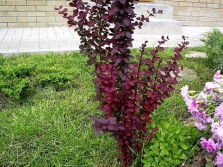
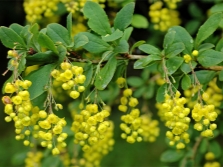

Kinds
Barberry has almost six hundred species.
Barberry Thunberg
In Russia, the most widespread barberry Thunberg. It grows wild in the Far Eastern territories of the country, but has also taken root in Europe, the USA and Canada. In Russia, this species is most often cultivated.
Barberry Thunberg is small in height, it can reach a maximum of 2.5 m. Its branches deviate from the trunk in the manner of arcs. Early shoots are bright red or orange. During the ripening period, they darken.The leaves are represented by the shape of a rounded rhombus. In spring and summer they have a bright green color, and in autumn they turn red. Barberry Thunberg has small spines. The flowers of the plant are yellow, but with a red tint on the outside. The berries are bright red and glossy.
Thunberg barberry is very often grown for decorative purposes, it can be found in some garden or park. It is planted in hedges, as well as along the curbs. The unusual color is especially noticeable in autumn, when the leaves and fruits have a bright color. Among other varieties of this species, there are those in which the color of the leaves is yellow or bright purple.

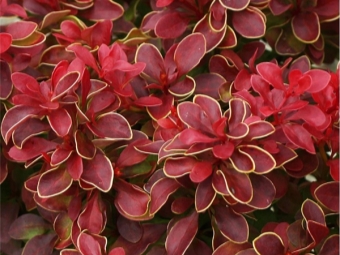
Where does it grow?
It is believed that the barberry originated from the countries of Central Europe and the Mediterranean. Now it can be found throughout Europe, as well as in the southern part of Russia. However, the barberry also tolerates cold well, so it can often be found in the wild and in areas with a temperate climate. Sometimes grows in Asian countries.

spice making method
Barberry leaves or berries are used as spices. The leaves are similar in taste to sorrel and give a piquant flavor to cabbage soup. They are used both dried and fresh. The same goes for berries. Sometimes they are used as a seasoning, then they are dried in the sun and then ground into a powder.
Leaves should also be dried in the fresh air, and not indoors.

How and where to choose a spice?
Barberry berries are on sale, the leaves are usually harvested on their own. When choosing berries, you should pay attention to their ripeness. Ripe berries are elliptical in shape and red or dark burgundy in color.


Peculiarities
Unripe barberry berries should not be eaten, as they contain poison.Another name for barberry is caramel tree.

Characteristics
Barberry has the following characteristics:
- used for medicinal purposes;
- actively used in cooking;
- serves as a honey plant;
- allows you to get paint from rhizomes and bark.

Nutritional value and calories
100 grams of barberry berries contain 29.6 kcal.
The nutritional value of the product includes the following components:
- proteins - 0 g;
- fats - 0 g;
- carbohydrates - 7.9 g;
- water - 82 g.
You can learn about the beneficial properties of barberry from an excerpt from the program "1000 and one spice of Scheherazade"
Chemical composition
Barberry contains the following components:
- vitamins: A (RE) - 23333.33 mcg; C - 500 mg; β-carotene - 140 mg; K - 0.5 mg;
- other chemical components: carotenoids (lutein, xanthophyll, zeaxanthin, flavoxanthin, auroxanthin, capsanthin, etc.); pectin substances; ash (0.96%); tannins; organic acids; alkaloids (berberine, palmatin, columbamine, etc.); malic and citric acids; resinous substances (up to 5.2% in leaves and up to 1.12% in bark and branches).
Beneficial features
Barberry has the following useful properties:
- cleanses the body;
- helps blood to clot in wounds;
- improves appetite;
- is a preventive measure against many diseases.
Barberry helps blood to clot in wounds due to the high content of pectin in it.

Harm
Barberry should be used with caution, as the following negative consequences are possible:
- miscarriage in pregnant women;
- drowsiness;
- lethargy;
- lethargy;
- convulsions;
- swelling on the skin;
- dizziness;
- vomit;
- nose bleed.
Contraindications
You should not use barberry in the following situations:
- pregnant women;
- children;
- women during feeding;
- in the presence of individual intolerance;
- in combination with sedatives;
- with kidney disease;
- in the presence of stones in the gallbladder;
- with heavy bleeding in women after menopause;
- with some types of hepatitis.

Juice
Barberry juice is obtained from fully ripe berries, which are very soft to the touch. It helps improve appetite and is also used as a mild laxative for irregular stools. It normalizes the work of the gastrointestinal tract and brings the body into tone. Also, barberry juice is used to reduce high fever during infections, and it serves as an excellent thirst quencher.

Application
In cooking
Barberry has an extensive list of uses in cooking:
- used as a spice for meat or rice in Asia (ground or dried whole);
- added to pilaf;
- the leaves are pickled or cut into salads;
- added to sausages;
- used as a spice in broths and many oriental dishes;
- jams, jelly, sherbet, juice, compote are made from berries;
- used in the preparation of marinades and sauces;
- used in the production of marshmallows and sweets, as well as mousses and marmalade;
- used in the production of alcohol (alcohol tinctures, liqueurs, etc.).
Barberry has a pronounced fruity aroma and gives dishes a pleasant refreshing sourness. Berries are stored in pickled, salted, and candied form. Barberry makes an excellent seasoning for game dishes.
Barberry honey has a pleasant golden color and a mild sweet taste. Slightly unripe fruits are subjected to salting and pickling. If the berries have a sour taste, then they go to the production of alcohol.


Candies
At home, delicious sweets are obtained from barberry according to the following recipe:
- you need a few tablespoons of sugar, 0.25 kg of barberry berries and an apple;
- the barberry is washed, placed in a saucepan, put on fire;
- a small amount of water and sugar are added to it;
- after boiling, the berries are boiled for 8 minutes;
- they are then crushed or pureed with an immersion blender;
- the apple is peeled and rubbed on a medium grater, and then mixed with barberry puree;
- spread the resulting mixture on a baking sheet in one layer and dry at a temperature of about 90 degrees for 5 hours;
- then the mixture is cut with a knife into strips and rolled into rolls.
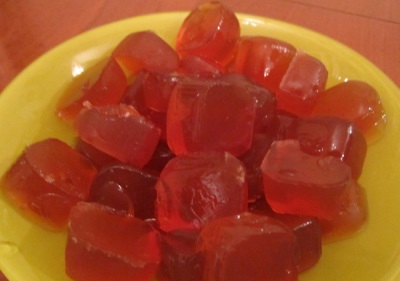
Compote
You can cook an excellent thirst-quenching compote or delicious jelly from barberry. Barberry pairs surprisingly well with apples. Compote of apples and barberry will perfectly refresh in the heat.
- You need 1 kg of apples, 0.2 kg of barberry, a liter of water and 350 g of sugar (an approximate amount is given).
- Apples are cut into slices and cleaned of seeds.
- Barberries and apples are placed in jars layer by layer.
- You need to prepare hot sugar syrup in advance.
- Fruits and berries are poured with this syrup and sterilized.

In medicine
Used in medicine barberry rootwith many medicinal properties.
Barberry is universal for medicine. Not only berries and leaves are actively used, but also bark and even rhizomes. Barberry has an unusually rich chemical composition, where alkaloids play the main role. The use of the plant for medicinal purposes is as follows:
- as a remedy for diseases of the gallbladder and liver;
- to increase blood clotting;
- to increase muscle contractions;
- to lower blood pressure;
- to provide a calming effect;
- as a remedy for colds;
- to remove harmful substances from the body;
- to prevent cancer and atherosclerosis;
- to improve the work of the heart;
- as a mild laxative;
- for the treatment of headaches;
- for the treatment of angina;
- against fever.
Tincture
At home, you can prepare barberry tincture with alcohol. To do this, the leaves are poured with alcohol 70% in a ratio of 1:5. Infuse them for 2 weeks until the mixture turns yellow. This tincture helps to treat certain types of hepatitis, with bleeding in the uterus, with diseases of the gallbladder.
It is also useful to take a tablespoon of juice per day.
You can make an infusion of barberry leaves. To do this, pour 15 g of leaves with a glass of boiling water and leave for 15 minutes. The infusion is recommended for the treatment of liver diseases and is taken after meals.
Barberry is also found in some medicines.


In cosmetology
Barberry infusions are used to rub the skin. Due to this, it becomes more elastic and smooth. Many hair masks also contain barberry, which helps strengthen hair and cure dandruff. The simplest version of a barberry rinse is a handful of berries boiled in water and infused for 40 minutes. The broth is filtered and rinsed with hair with each wash.

At home
The household use of barberry is as follows:
- used in official medicine;
- used in cooking;
- various crafts are often made from branches;
- barberry roots contain dyes for silk fabric and leather;
- from the berries produce a dye for linen and paper;
- helps with weight loss.

cultivation
reproduction
There are several ways to propagate barberry:
- Cherenkovy. Cuttings are cut and planted in greenhouses.They need to grow there under the film, it is allowed to water them with means that accelerate growth. Greenhouses need to be ventilated periodically. As soon as the first leaves appear, the greenhouse is kept open. The soil must be constantly loosened.
- Seminal. Seeds obtained from barberry berries are soaked in a dilute solution of potassium permanganate and sown in the autumn months, but before severe cold snaps. Literally a year later, the strongest seedlings are selected from the seedlings, which need to be transplanted already to a permanent place of growth.
- By division. It is necessary to cut off part of the parent bush, but the roots cannot be damaged.
Landing and care
Barberries are planted in soil with a normal level of acidity, although a slight increase is allowed. When planting bushes alone, they should be seated at least 2 m apart from each other. If the goal is to form a living fence, then the bushes are planted in a pre-dug trench in the calculation that there are 2 bushes per 1 m.
For barberry, it is unprincipled whether to grow in the shade or in the sun. However, the sun is preferable, as the decorative properties in the shade can be lost.
The plant is not capricious, so it is easy to care for it. You can water once a week, and it is recommended to fertilize the bushes in the first spring after planting. Fertilizers should be rich in nitrogen. Then the barberry is fertilized with nitrogen after a few years. The use of fertilizers rich in trace elements is allowed.
The plant needs to be loosened often, as its roots go deep. Barberry lends itself well to shearing, and low-growing species generally sometimes do without it.


For more about barberry, see the following video.
Interesting Facts
- Mentions of the barberry were found on the tablets kept in the library fund of the ruler of Assyria even before our era.
- In some US states, barberry cannot be grown, as it is considered a "monopolistic" plant that gradually out-competes other plants.
- Over the past decade, scientists have found that barberry can be used as a substitute for Viagra.
- In ancient empires, barberry was considered a plant that brings happiness.


















I always add barberry to pilaf. Such a small sourness gives specialty to the dish.